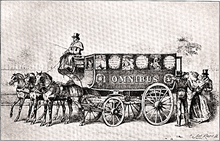Horsebus
The driver sat on a separate, front-facing bench, typically in an elevated position outside the passengers' enclosed cabin.
Especially popular around 1870–1900, these vehicles were known as 'private omnibuses' or 'station buses'; coachman-driven, they would usually accommodate four to six passengers inside, with room for luggage (and sometimes additional seating) on the roof.
[1] A small open wagon with or without a top, but with an arrangement of the seats similar to horse-drawn omnibuses, was called a wagonette.
A legend, promoted by the French Transportations Museum website, says the name is derived from a hatter's shop of the Omnes family in front of the first station opened in Nantes by Stanislas Baudry in 1823.
[2] Though it is undisputed that the term arose with Stanislas Baudry's company, there is no record of any Omnès hatter living in that street.
Baudry used to call his horsecars Dames blanches (White ladies), a name which, critics told him, made no sense.
[3] The first known public bus line (known as a "Carriage" at that time) were carrosses à cinq sols launched by Blaise Pascal in 1662 in Paris.
His pioneering idea was to offer a service where, unlike with a stagecoach, no prior booking was necessary and the driver would pick up or set down passengers anywhere on request.
[5] In 1833, legislation was passed to allow these long-bodied vehicles to ply the streets of the city, provided the drivers and conductors took out a license and wore a badge with a number on it.
In 1827 he commissioned an English coach-maker, George Shillibeer, to design a vehicle that could be stable and carry a large number of passengers.
In 1855, Napoleon III had them combined into a single company, the Compagnie générale des omnibus, with a monopoly on Paris public transportation.
On London omnibuses, the introduction of the clerestory roof in 1847, to provide more headroom inside, allowed the provision of a longitudinal seat on the upper deck.
These horse drawn trams were converted to cable-drawn cars in some larger cities, as still exist in San Francisco, the underground cable being driven by stationary steam engines.
At around 1890, electric propulsion became practical and replaced both the horse and the cable and the number of tram lines expanded exponentially.
The last recorded horse omnibus in London was a Tilling bus which last ran, between Peckham and Honor Oak Tavern, on 4 August 1914.






